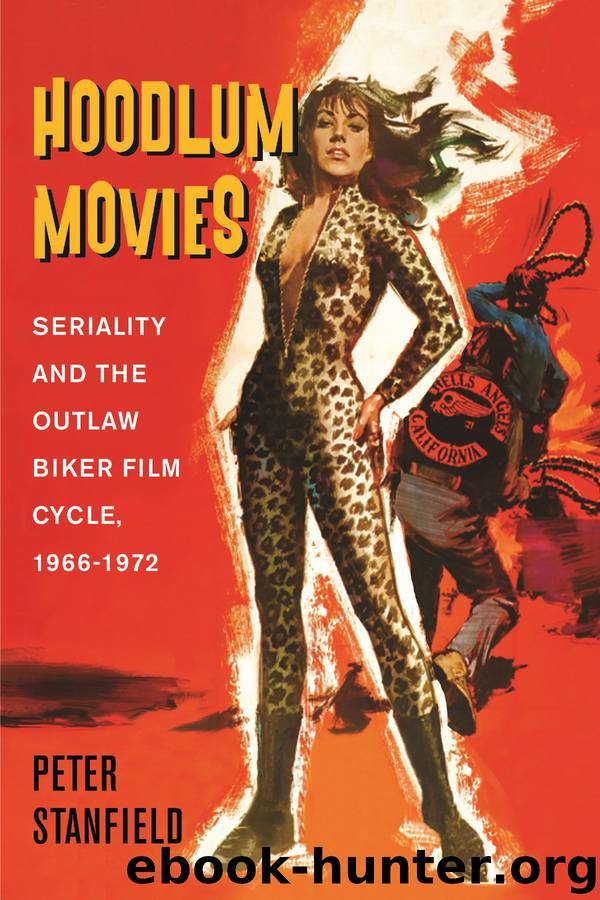Hoodlum Movies by Peter Stanfield

Author:Peter Stanfield
Language: eng
Format: epub
Tags: PER004100 Performing Arts / Film & Video / Genres / Crime, PER004020 Performing Arts / Film & Video / Guides & Reviews, SOC022000 Social Science / Popular Culture
Publisher: Rutgers University Press
This advertisement for Run, Angel, Run! showcases the figure of William Smith surrounded by the film’s main attractions: the stunts, the cavalcade of bikers, barroom brawling, rape, and go-go dancing.
“I think you’ve seen too many motorcycle movies,” says Ann-Margaret to Sid Haig in C.C. and Company as he tries to drag her into the back of a car. In the film, exploitation regular Haig (Spider Baby and Pit Stop) wears headgear plundered from the set of an Attila the Hun or Genghis Khan picture. Filmed on location in Tucson, Arizona, and Las Vegas, the core of the film is centered on a motocross race, which provides high-speed bike action, stunts, and pratfalls. Ex–football star Joe Namath plays a member of the Heads motorcycle club, which is led by Moon, played by Fanfare’s outlaw biker in residence William Smith. Unlike Smith in Run, Angel, Run!, Namath gets to quit the gang and win the girl.
C.C. and Company was the only film in the cycle to be produced by a major company, Avco, and with his supporting role, Smith had shown he’d outgrown Fanfare’s budget-line affairs. His new status was consolidated by starring with Tom Baker in Corman’s New World Pictures’ Angels Die Hard (1970) and the following year’s stretch with AIP in Chrome and Hot Leather. Variety wrote of the former that it was “a good exploitation programmer in a genre which seems on a decline.”27 Obviously, Roger Corman did not share this pessimistic view of the cycle’s waning; the film was one of three biker pictures he would release through his production and distribution company in 1970–1972.
New World Pictures was launched in June 1970 with the announcement of four films before the year’s end and another in 1971. The principal stockholders were Roger Corman, his brother Gene, and theaterman and producer Larry Woolner. Angels Die Hard was their first feature release, followed by Student Nurses. None of the pictures would be X-rated. Budgets for the films were pegged between $500,000 and $800,000, with $3 million committed to production. Three hundred prints would be struck for each title, or at least that was the ballyhoo.28 In reality, budgets rarely exceeded $200,000, and around one hundred prints were struck.
Speaking to a Boxoffice reporter about his experience as an exhibitor, Woolner noted that “two main factors stand out in making value judgments: The type of campaign organized by the distributor and the title of the film. ‘Good titles are the main attraction of many pictures, especially in the action field . . . The title is of prime importance for films playing drive-ins, even more so than walk-ins.’” He preferred “a fresh picture booked directly into a drive-in theatre to a big budget, highly promoted, audience-drained film after it had played the shopping center luxury hardtops.”29
Corman had moved on from AIP because he was not getting the financial rewards he considered to be his due and because Nicholson and Arkoff interfered with the final cut of his films, taking the edge off the sex and violence.
Download
This site does not store any files on its server. We only index and link to content provided by other sites. Please contact the content providers to delete copyright contents if any and email us, we'll remove relevant links or contents immediately.
Cecilia; Or, Memoirs of an Heiress — Volume 1 by Fanny Burney(32434)
Cecilia; Or, Memoirs of an Heiress — Volume 2 by Fanny Burney(31871)
Cecilia; Or, Memoirs of an Heiress — Volume 3 by Fanny Burney(31854)
The Great Music City by Andrea Baker(31349)
We're Going to Need More Wine by Gabrielle Union(18967)
All the Missing Girls by Megan Miranda(15571)
Pimp by Iceberg Slim(14394)
Bombshells: Glamour Girls of a Lifetime by Sullivan Steve(13973)
Talking to Strangers by Malcolm Gladwell(13222)
Norse Mythology by Gaiman Neil(13206)
Fifty Shades Freed by E L James(13157)
For the Love of Europe by Rick Steves(12992)
Mindhunter: Inside the FBI's Elite Serial Crime Unit by John E. Douglas & Mark Olshaker(9201)
Crazy Rich Asians by Kevin Kwan(9167)
The Lost Art of Listening by Michael P. Nichols(7406)
Enlightenment Now: The Case for Reason, Science, Humanism, and Progress by Steven Pinker(7235)
The Four Agreements by Don Miguel Ruiz(6631)
Bad Blood by John Carreyrou(6552)
Weapons of Math Destruction by Cathy O'Neil(6146)
